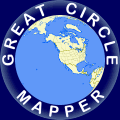Featured Map for 24 March 2023:
Introducing Bézier Paths
The Featured Map ten days ago introduced rhumb lines as a new path type, as an alternative to the usual geodesic ("great circle") paths. As noted then, rhumb lines may not see much use as more than a curiosity. Today's Featured Map introduces another new path type, one which is likely to have greater utility.
The Featured Map on 11 January 2023 included a trio of routes which sat atop each other. From the notes on that Featured Map:
One quirk of the map is that it looks like Alaska might fly the A321neo from Chicago O'Hare to New York, either to JFK or to Newark or even to both. That's an illusion due to the geodesic ("great circle") path from San Francisco to New York passing almost directly over O'Hare. (That might be a topic for a future Featured Map!)
This is that future Featured Map.
Although geodesic paths depict the shortest path on the globe, they may not resemble the paths actually flown (due to winds and other factors), and they can do a truly poor job of portraying an airline's network. A classic example of the latter dichotomy is the diagram of the London Underground (the Tube Map) that Harry Beck created in 1931: although it is severely distorted from physical reality, it is brilliantly useful.
Enter Bézier curves, named for French automotive engineer Pierre Bézier, which in their cubic form augment the end points of a path with two control points to define a smooth curve, arbitrary other than with regard to the four points. Depending upon the chosen control points, this curve might resemble the geodesic path, or might be wildly different.
Over 20 years ago, Brian Reid, then at the Digital Equipment Corp. (DEC) Western Research Laboraoties (WRL) in Palo Alto, Califoria, produced a series of maps (er, diagrams) of traffic flows in both the Usenet and UUCP networks. They used Bézier curves, and he was kind enough to share his code for choosing the control points. It turned out to be difficult to integrate into the original Great Circle Mapper, one of many problems which led to a rewrite of the site (known as GC2 if you're amongst the one people, er, person, in-the-know) to the current web site.
Several years after the debut of GC2 in 2010, the idea of using Brian's work was revived. Brian is really smart but with a dullard like yours truly at the helm it worked for some cases but failed miserably for others and was again set aside.
January's Alaska Airbus map again ignited that desire to find a different way of portraying paths. Rather than "boiling the ocean" with automatic selection of Bézier control points, it seemed like user-definable control points might offer a useful step even if the ease of use falls short of the goals of the Great Circle Mapper. My flights from San Francisco to Phoenix (and return) for the Cranky Network Awards provided time to enhance the software to support Bézier curves as a path type.
(Many thanks to everyone who expressed enthusiasm and support at that event!)
Bézier paths are still a work-in-progress in that the default parameters are useless but after over 20 years it's time to release it despite the warts.
Today's Featured Map again shows Alaska Airlines' Airbus flights from San Francisco to Chicago, New York (JFK), and Newark, with the geodesic paths in red even though it looks like just one path, and with the three routes diagrammed in green using Bézier paths to clearly show what Alaska Airlines flies. More information about Bézier paths and how to configure them is in the FAQ.
References and additional information:
- Tube map – Transport for London
- When Topology Trumped Topography: Celebrating 90 Years of Beck's Underground Map
- The Birth of Bézier Curves & How It Shaped Graphic Design (28 October 2022)
- Flowing From Site to Site: Brian Reid's USENET Traffic Flow Maps (circa 1986-95)
- Alaska Airlines
- 2023 Cranky Network Awards
- Featured Map: Pi(rates) and Rhumb (14 March 2023)
- Featured Map: Alaska's Dwindling Airbus Fleet (11 January 2023)
- Featured Map: The First 24 Hours (14 January 2010)
|
Information on this site may not be accurate or current and is not valid for flight planning or navigation. No warranty of fitness for any purpose is made or implied. Flight planning and navigation should only be done using official charts.
Copyright © 2010-2024
Karl L. Swartz.
All rights reserved.
|
